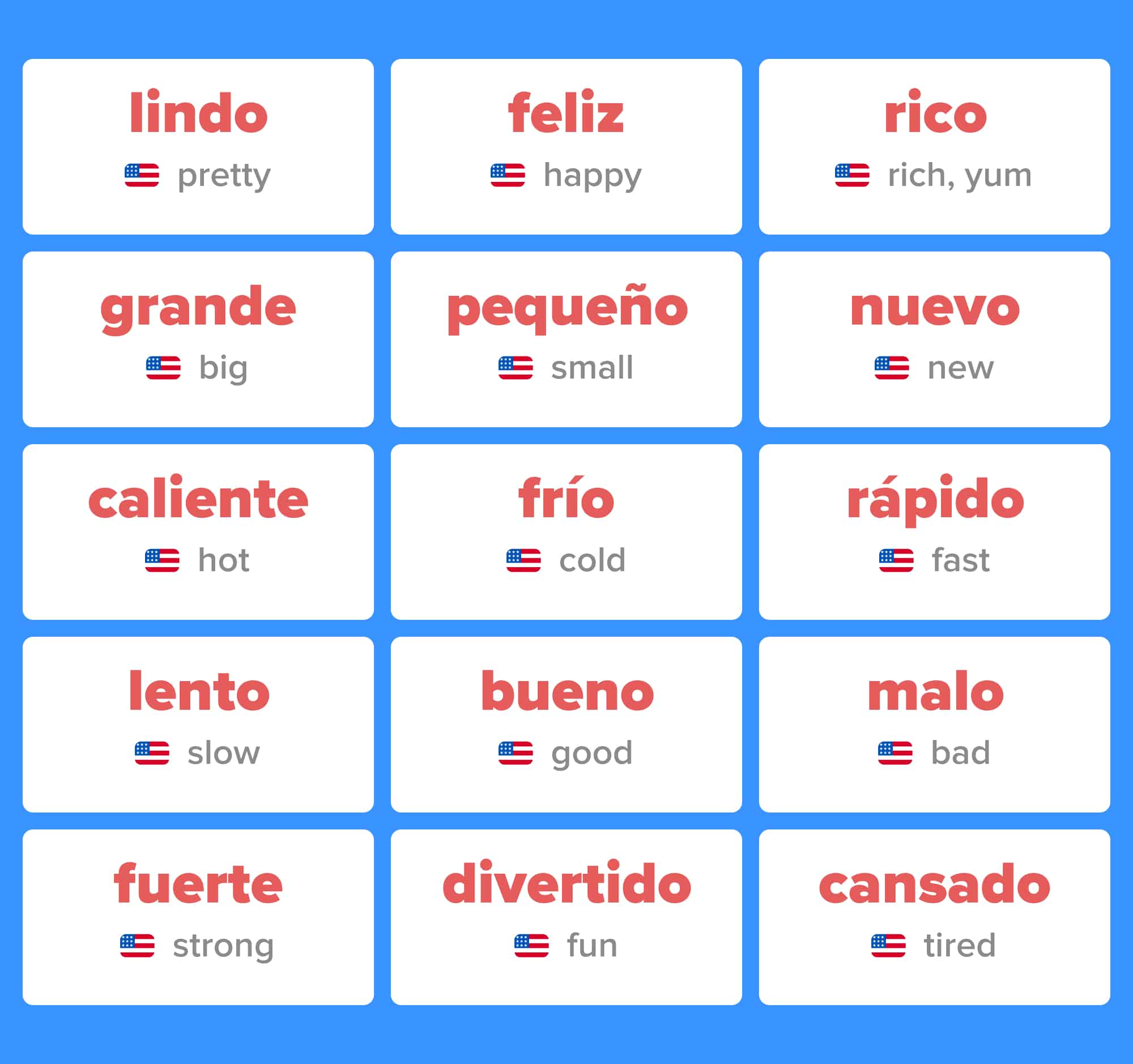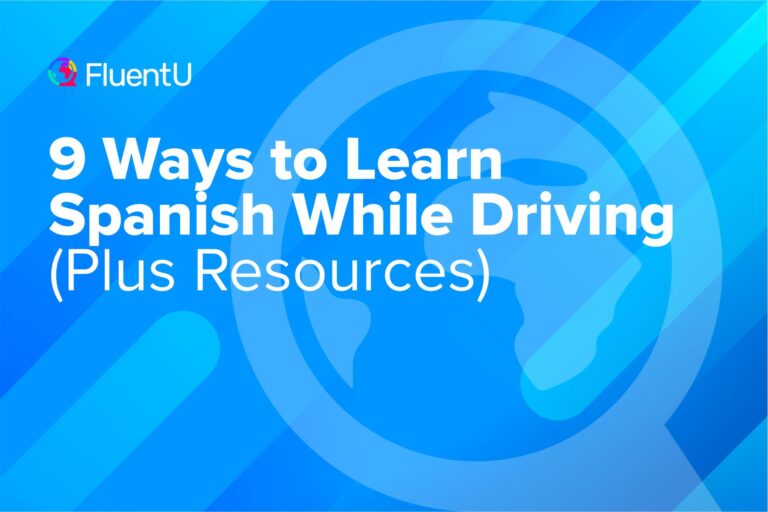Contents
- Common Spanish Adjectives You Should Know
- 1. Abierto — Open
- 2. Aburrido — Boring
- 3. Alto — Tall
- 4. Bajo — Short
- 5. Barato — Cheap
- 6. Bueno — Good
- 7. Caluroso — Hot
- 8. Cansado — Tired
- 9. Caro — Expensive
- 10. Cerrado — Closed
- 11. Complicado — Complicated
- 12. Débil — Weak
- 13. Delgado — Thin
- 14. Delicioso — Delicious
- 15. Despierto — Awake
- 16. Divertido — Fun
- 17. Dulce — Sweet
- 18. Enfermo — Sick
- 19. Feliz — Happy
- 20. Feo — Ugly
- 21. Frío — Cold
- 22. Fuerte — Strong
- 23. Gordo — Fat
- 24. Grande — Big
- 25. Injusto — Unfair
- 26. Inteligente — Intelligent
- 27. Justo — Fair
- 28. Lento — Slow
- 29. Limpio — Clean
- 30. Lindo — Pretty
- 31. Lleno — Full
- 32. Loco — Crazy
- 33. Malo — Bad
- 34. Mojado — Wet
- 35. Nuevo — New
- 36. Pequeño — Small
- 37. Pobre — Poor
- 38. Rápido — Fast
- 39. Repugnante — Disgusting
- 40. Rico — Rich, yum
- 41. Salado — Savory, Salty
- 42. Sano — Healthy
- 43. Seco — Dry
- 44. Simple — Simple
- 45. Sucio — Dirty
- 46. Tonto — Stupid
- 47. Tranquilo — Tranquil, Calm
- 48. Triste — Sad
- 49. Vacío — Empty
- 50. Viejo — Old
- Spanish Adjective Grammar
- Frequently Asked Questions About Spanish Adjectives
- And One More Thing…
50 Most Common Spanish Adjectives [With PDF Download]

Knowing adjectives in Spanish makes expressing yourself infinitely easier. And since native speakers use them everyday, it’ll make Spanish easier to understand, too.
So in this post, you’ll learn 50 common Spanish descriptive adjectives and how to use them correctly in sentences.
Download: This blog post is available as a convenient and portable PDF that you can take anywhere. Click here to get a copy. (Download)
Common Spanish Adjectives You Should Know
For this post, all adjectives will be written in masculine singular. When you want to change the adjectives to the feminine, often the end of the adjective will change to -a. There are a few exceptions which you will be able to read about below.
Here is a quick overview of the most essential Spanish adjectives:

Now, here are some more useful adjectives you’re bound to find useful!
1. Abierto — Open
Deja la puerta abierta, por favor. — Leave the door open, please.
2. Aburrido — Boring
El libro es muy útil pero aburrido. — The book is very helpful but boring.
3. Alto — Tall
Le gustan las chicas altas. — She likes tall girls.
4. Bajo — Short
Algunas personas son bajas. — Some people are short.
5. Barato — Cheap
Compra ese, es más barato. — Buy that one, it’s cheaper.
6. Bueno — Good
Hacer ejercicio es muy bueno para la salud. — Exercising is very good for your health.
7. Caluroso — Hot
El día está caluroso. — The day is hot.
8. Cansado — Tired
Dormí mal y estoy muy cansada. — I slept badly and I’m really tired.
9. Caro — Expensive
¿Salió muy caro el pasaje a Chile? — Was the ticket to Chile too expensive?
10. Cerrado — Closed
La tienda está cerrada hasta las cinco de la tarde. — The shop is closed until 5 in the afternoon.
11. Complicado — Complicated
La situación está un poco complicada, así que es difícil hablarlo. — The situation is a bit complicated, so it’s difficult to talk about it.
12. Débil — Weak
Estoy débil porque estuve enfermo la semana pasada. — I am weak because I was sick last week.
13. Delgado — Thin
Mis primos son muy delgados. — My cousins are very thin.
14. Delicioso — Delicious
Creo que la comida mexicana es la más deliciosa. — I think Mexican food is the most delicious.
15. Despierto — Awake
¿Todavía estás despierto? — Are you still awake?
16. Divertido — Fun
Juan es divertido. — Juan is fun.
17. Dulce — Sweet
Gracias, eres muy dulce. — Thanks, you’re so sweet.
Este vino está demasiado dulce. — This wine is too sweet.
18. Enfermo — Sick
No puedo salir esta noche; estoy enferma. — I can’t go out tonight, I’m sick.
19. Feliz — Happy
Me haces muy feliz. — You make me very happy.
20. Feo — Ugly
Esta camisa es muy fea. — This shirt is so ugly.
21. Frío — Cold
¡Que frío hace! — It’s so cold!
22. Fuerte — Strong
Si vas al gimnasio todos los días, te harás fuerte. — If you go to the gym everyday, you’ll get strong.
23. Gordo — Fat
Como mi cuaderno está lleno, también está gordo. — Because my notebook is full, it’s also fat.
24. Grande — Big
Tiene una sonrisa muy grande. — He has a very big smile.
25. Injusto — Unfair
¡Qué injusto! — How unfair!
26. Inteligente — Intelligent
Me encanta mi novio porque es muy inteligente. — I love my boyfriend because he’s very intelligent.
27. Justo — Fair
El juez fue justo. —The judge was fair.
28. Lento — Slow
Soy un poco lento al conducir. — I’m a little slow when driving.
29. Limpio — Clean
Me gusta que mi casa esté limpia todo el tiempo. — I like my house to be clean all the time.
30. Lindo — Pretty
¡Qué lindos son! — They’re so pretty!
31. Lleno — Full
Mi cuaderno está lleno de nuevas palabras en español. — My notebook is full of new Spanish words.
32. Loco — Crazy
El trabajo me está volviendo loco. — Work is driving me crazy.
33. Malo — Bad
Comer muchos dulces es malo para la salud. — Eating lots of sweets is bad for your health.
34. Mojado — Wet
Llovió anoche y la ropa quedó toda mojada. — It rained last night and the laundry got all wet.
35. Nuevo — New
Su vestido nuevo era caro. — Her new dress was expensive.
36. Pequeño — Small
Mi departamento es demasiado pequeño. — My apartment is too small.
37. Pobre — Poor
La chica es muy pobre. — The girl is very poor.
38. Rápido — Fast
Él es el chico más rápido de la escuela. — He is the fastest boy in school.
39. Repugnante — Disgusting
El olor que sale de la cocina es repugnante. — The smell coming from the kitchen is disgusting.
40. Rico — Rich, yum
Ella es rica. — She is rich.
¡El postre estuvo muy rico! — The dessert was so yum!
41. Salado — Savory, Salty
Prefiero la comida salada. — I prefer savory food.
42. Sano — Healthy
Hago ejercicio todos los días porque me hace sentir sana. — I exercise everyday because it makes me feel healthy.
43. Seco — Dry
El pan de esa panadería es un poco seco. — The bread from that bakery is a little dry.
44. Simple — Simple
La comida es demasiado simple para mí. — The food is too simple/bland for me.
45. Sucio — Dirty
Este carro se ve algo sucio. — This car looks a bit dirty.
46. Tonto — Stupid
¡No seas tonto! — Don’t be stupid!
47. Tranquilo — Tranquil, Calm
Tranquilo, todo estará bien. — (Be) calm, everything will be fine.
48. Triste — Sad
Todos nos sentimos tristes cuando termina la canción de Pharrell. — We all feel sad when Pharrell’s song is over.
49. Vacío — Empty
Mi vida está vacía sin él. — My life is empty without him.
50. Viejo — Old
El reloj de mi papá es muy viejo. — My dad’s watch is very old.
If you want more help learning these adjectives, you could check out a YouTube video such as this one to have a visual element to your studies:
Spanish Adjective Grammar
Where Does an Adjective Go In a Spanish Sentence?
Many beginners struggle to get their heads around the order of adjectives in Spanish.
But remember that unlike in English, Spanish descriptive adjectives usually go after the noun.
So instead of saying “He has beautiful blue eyes,” you say the equivalent of “He has eyes blue beautiful”: Tiene unos ojos azules preciosos.
It might sound weird at first, but once you get the idea, nouns before adjectives will come naturally to you. Check out this post for more in-depth info on the topic.
Importance of Gender and Number
Another important thing to remember is that you need to consider whether the adjective is masculine, feminine, singular or plural. Spanish adjectives must agree with gender and number.
For example, the word lindo (pretty) can have four different forms, depending on what it’s referring to:
| Masculine | Feminine | |
|---|---|---|
| Singular | Lindo | Linda |
| Plural | Lindos | Lindas |
That means if you’re talking about a plural, feminine noun—like palabras (words)—you’d need the plural, feminine adjective.
¡Qué lindas palabras! (What beautiful words!)
Adjectives That Don’t Change With Gender
On top of all that, there are some adjectives that don’t change with gender. These mostly follow a pattern. As a general guideline you can remember this, plus a few common examples:
- Adjectives that end with -ista: realista (realistic), idealista (idealistic), materialista (materialistic)
- Adjectives that end with -e: grande (big), caliente (hot), interesante (interesting), inteligente (intelligent)
- Adjectives that end with -or (comparatives): mejor (better), menor (less), peor (worse)
- Adjectives that end with a consonant: gris (gray), azul (blue), marrón (brown), fácil (easy), feliz (happy)
Note that while these adjectives don’t change with gender, they do change with number, so make sure to use their plural form (realistas, grandes, mejores …) when you use them for plural words.
Of course, adjectives can behave quite differently in the wild, away from the confines of this article! To really understand how native Spanish speakers use adjectives, you may need to eavesdrop on some conversations.
Or get a program like FluentU and find tons of authentic videos for all your adjective-learning needs.
FluentU takes authentic videos—like music videos, movie trailers, news and inspiring talks—and turns them into personalized language learning lessons.
You can try FluentU for free for 2 weeks. Check out the website or download the iOS app or Android app.
P.S. Click here to take advantage of our current sale! (Expires at the end of this month)

Frequently Asked Questions About Spanish Adjectives
What Are the Four Forms of Spanish Adjectives?
Adjectives in Spanish come in four forms to agree in gender and number with the nouns they modify. These forms are feminine singular, feminine plural, masculine singular and masculine plural.
For example, the adjective grande (meaning “big”) would have the forms grande (masculine singular), grandes (masculine plural), grande (feminine singular), and grandes (feminine plural), depending on the noun it modifies. Though, as mentioned above, there are some adjectives that don’t change with gender.
What Are Possessive Adjectives?
Possessive adjectives in Spanish indicate ownership or possession. They agree in gender and number with the noun they modify, and they come before the noun.
The possessive adjectives are mi (my), tu (your), su (his/her/its/your [singular, formal]), nuestro/a (our), vuestro/a (your [plural, Spain]), and su (their/your [plural, formal]). For example, mi casa means “my house” and su libro can mean “his book,” “her book,” “its book,” “your (formal) book,” or “their book.”
What Are Demonstrative Adjectives?
Demonstrative adjectives in Spanish indicate the proximity of the noun they modify in relation to the speaker. They also agree in gender and number with the noun they modify.
The demonstrative adjectives are este (this), ese (that), aquel (that over there), and their respective feminine and plural forms. For example, esta casa means “this house,” esos libros means “those books,” and aquellas flores means “those flowers over there.”
So, go on and be un(a) estudiante bueno/a (a good student) and learn this whole list!
It’ll be divertido (fun), simple (simple) and you’ll come across as really inteligente (intelligent) once you’re using these adjectives in your everyday Spanish life.
Download: This blog post is available as a convenient and portable PDF that you can take anywhere. Click here to get a copy. (Download)
And One More Thing…
If you've made it this far that means you probably enjoy learning Spanish with engaging material and will then love FluentU.
Other sites use scripted content. FluentU uses a natural approach that helps you ease into the Spanish language and culture over time. You’ll learn Spanish as it’s actually spoken by real people.
FluentU has a wide variety of videos, as you can see here:

FluentU brings native videos within reach with interactive transcripts. You can tap on any word to look it up instantly. Every definition has examples that have been written to help you understand how the word is used. If you see an interesting word you don’t know, you can add it to a vocab list.

Review a complete interactive transcript under the Dialogue tab, and find words and phrases listed under Vocab.

Learn all the vocabulary in any video with FluentU’s robust learning engine. Swipe left or right to see more examples of the word you’re on.

The best part is that FluentU keeps track of the vocabulary that you’re learning, and gives you extra practice with difficult words. It'll even remind you when it’s time to review what you’ve learned. Every learner has a truly personalized experience, even if they’re learning with the same video.
Start using the FluentU website on your computer or tablet or, better yet, download the FluentU app from the iTunes or Google Play store. Click here to take advantage of our current sale! (Expires at the end of this month.)







